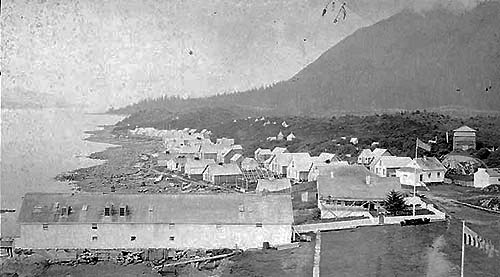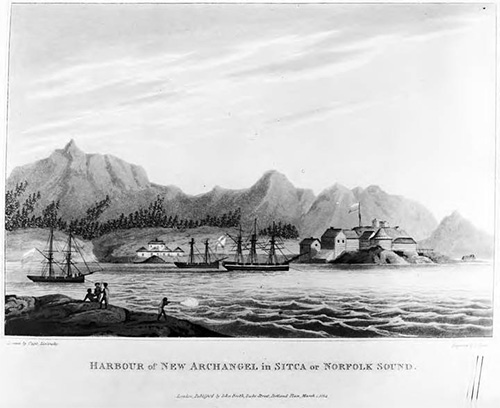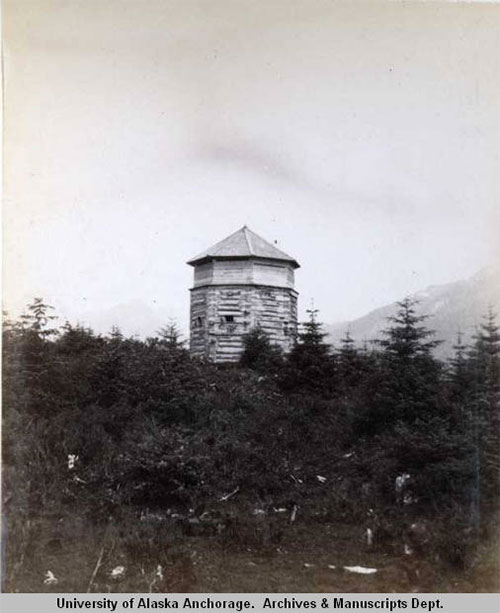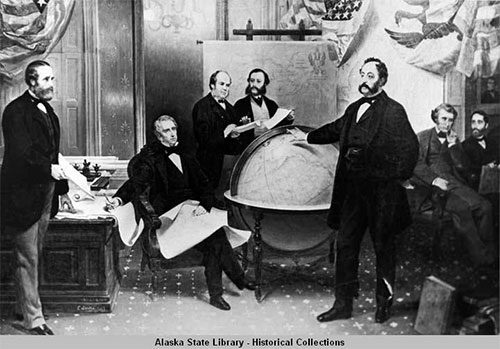
150th ALASKA DAY: What We're CommemoratingBy JUNE ALLEN
October 18, 2017
The United States consummated its Purchase of Alaska on the afternoon of October 18, 1867 as the Southeastern's October rains held off long enough for Russia's imperial double eagle flag to be lowered and the Stars and Stripes raised to flap wildly in the autumn winds atop a 90-foot flagpole on Castle Hill in Sitka. Few or none of either nation's dignitaries and troops standing at attention below during the ceremony were particularly happy about the event. Neither were the Tlingits from the nearby village, who were not allowed to attend.
The transfer ceremony had not run smoothly. The Russian flag had tangled and a bosun's chair had to be raised to cut the flag loose. It fluttered down and landed on a raised bayonet of a soldier below. At the sight, a Russian Princess fainted, demonstrating the general feelings of the Russian inhabitants. The American troops, unhappy over having been kept aboard the gunboats in Sitka harbor for ten days before the transfer rituals, were cranky and ready for some shore leave. Each side reflected the attitudes of their respective nations. Some of the Russians interests had not wanted to sell, and Americans, stirred up by editorials and cartoons in the national press, thought the Alaska Purchase was silly, expensive and unnecessary. No money had yet changed hands. It would be months before a tightfisted Congress would let loose of the $7,200,000 to pay for the sale arranged by Secretary of State William Henry Seward on March 30 of that same year. That is the day we now celebrate as Seward's Day. But from that day on, the remarkable Russian-Alaska capital of New Archangel would be known as the American village of Sitka, to serve as Alaska's capital for the next 30-plus years.
Alaska had been claimed for Russia as early as 1741 after Vitus Bering sighted the mountain he named St. Elias and landed near Yakutat for a cursory exploration. The Russian-American company was formed to settle the new country to utilize the great untapped sea otter resource. By 1800 Kodiak was established, Sitka was under construction, and outposts were being established that would reach from the Kenai, into the Bering Sea and up the Yukon River at Nulato. The Russian-American Company tried to establish a colony of farmers at Yakutat, but the transplanted Russian peasants hated the vast wilderness, the climate and their hostile native neighbors. The agricultural experiment failed. Sitka, however, under the governance of Russian-American Company manager Alexander Baranof, grew into a significant city. Baranof was a small man who wore a scarf tied under his chin to secure his wig in Sitka's whimsical winds. He married a native woman, raised their two children as upper class citizens, and created a city that was, according to some sources, called the Paris of the North. Sitka, planned and begun by Baranof, had a large church and a seminary, a hospital, schools and even a college, an orchestra, a sawmill, a foundry, a shipyard, a harbor light, Baranof's "Castle" with its parade ground, and all the amenities that could be provided in a remote location on the North Pacific Coast. It was the concept of Manifest Destiny that led to the first ideas about a purchase of Alaska by the United States. The U.S., even through several disputes over U.S. ships in Alaska's waters, had maintained friendly relations with Russia. In fact, during the Civil War (1861-1865), Russian warships stood off New York Harbor as a show of friendship for the Union. But there was Manifest Destiny ("Go west, young man!"), the belief that westward-ho Americans would sooner or later - probably sooner - reach the Pacific Coast and take a greater interest in Pacific shipping and trade. Americans were seen by much of the rest of the world as aggressive and violent people. The Russians feared that if they didn't sell Alaska to the U.S., the Americans would simply turn their westward ho movement northward and take Alaska for themselves.
The unexpected success of Sitka and its business practices led to other international concerns. When the news of the California Gold Rush of 1849 spread around the world, Russian Sitka jumped in at once and provided that fledgling coastal city with lumber, coal and fish and even barged ice to cool the whiskey of the Forty-Niners. It's said that the bells of the California Missions were cast in Sitka's foundry. Russian ships navigating their long shipping route around Africa's Cape Horn and into the Pacific routinely stopped at Honolulu to trade for fruit, vegetables and other provisions for the Russian colony in Alaska. So the ships made stops at brand new San Francisco to sell a portion of the produce. This new market caught the attention of the boasting British who proclaimed that "Britannia Rules the Waves." Britain took a new interest in the Pacific. The world's attention was focused on California. Gold Rushes have a habit of alerting the world to geography, politics and possibilities of remote locations. It was understood that the U. S. expansion west was facing new problems. There was to be the problem of the international boundary between Canada and the Pacific Coast states-to-be, the "54-40 or fight." And somehow Alaska was brought into the overall picture. This was where ambitious Secretary of State and presidential hopeful William Henry Seward came intothe picture. Seward had something specific in mind: acquiring Canada and then Alaska into one huge, northern hemisphere United States of America. Seward sincerely believed that Britain would withdraw from Canada and the Canadians would ask to become part of the United States - and Alaska would be a natural extension of that territorial expansion. That didn't happen. But Seward continued to believe in the wisdom of buying Alaska. After many negotiations, Seward closeted himself with the Russian representative and the two of them pounded out an agreement for the sale of Alaska for $7,200,000 - about two-and-half cents an acre. In the wee hours of March 30, 1867, the agreement was reached. The purchase issue then went to Congress where Senator Charles Sumner delivered a three-hour oration in favor of the purchase, its value to the nation, and its sign of political goodwill with Russia.
The Purchase of Alaska was finally approved by ONE VOTE! William Henry Seward visited Alaska the following year. His first stop was at Tongass Village on Tongass Island along the entrance to Portland Canal, where he was entertained at a potlatch. There is a Seward totem pole in the Saxman Totem Park. It is a shame pole with red paint on the face, said to have been carved because Seward didn't understand the potlatch concept and rules. There is another possibility, however. Seward's face was terribly scarred and possibly that's why his face is painted that way? When President Abraham Lincoln was shot the evening of April 14, 1865, his was the only successful assassination within a plot of larger dimensions. Another assassin was to shoot Secretary of War Edwin M. Stanton but somehow that attempt failed to materialize. A third assassin's target was Secretary of State William H. Seward. The man burst through Seward's front door and failing to see the Secretary of State, rushed upstairs where the Seward was in bed recovering from injuries to his face suffered in a carriage accident shortly before. The assassin aimed and pulled the trigger but the gun failed to fire! In a panic, the man pulled a knife and lunged toward the bed. But Seward's grown son had entered the room by then and subdued the man - who got free, ran down the stairs and escaped on his horse. He was later caught, however, and executed with the others involved in the plot. Three years later Seward, the man who negotiated the Purchase of Alaska, made his trip to Alaska where today he has not only a city, but a number of geographical places - plus a totem pole - named in his honor.
Note: This Alaska Day column was first published by SitNews October 18, 2002. Republished and updated in remembrance of June Allen. Editing by Mary Kauffman, SitNews
Representations of fact and opinions in comments posted are solely those of the individual posters and do not represent the opinions of Sitnews.
|
||||||



